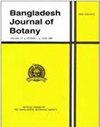建筑垃圾粘土砖对辣椒生长及粘土性能改善的影响
IF 0.3
4区 生物学
Q4 PLANT SCIENCES
引用次数: 0
摘要
通过盆栽试验、室内检测和三轴试验,研究了建筑垃圾粘土砖对辣椒生长、改善粘土营养和强度性能的影响。将陕南土轧制筛选2mm,将建筑垃圾粘土砖磨成0-2、2-5、5-7 mm。将不同粒径的建筑垃圾与粘土按0:1 (CK)、1:1、1:2、1:3的质量比进行混合。建筑垃圾在四种混合基质中的比重分别为0、50、33和25%。约33~50%的5~7mm粒径的建筑垃圾粘土砖与纯粘土混合后,其营养水平高于纯粘土。建筑垃圾粘土砖中栽培辣椒的株高和产量最高,为33~50%,掺纯粘土的粒径为5~7mm,土壤强度比纯粘土高33.2%。该处理为植物生长提供了充足的营养条件。这不仅为辣椒的生长提供了充足的营养条件,而且满足了相应的抗剪强度和对粘土区土壤改良的适宜性,特别是对粘土质边坡稳定性的提高。探讨了建筑垃圾在土地工程建设和土壤有机改造中的应用价值和前景,确定了建筑垃圾资源化利用的新途径。[j] .植物学报,52(2):503- 514,2023(6):特刊本文章由计算机程序翻译,如有差异,请以英文原文为准。
Effects of construction waste clay bricks on growth of pepper and improvement of clay properties
Pot experiment, indoor detection and triaxial experiment were carried out to study the effects of construction waste clay bricks on the growth of pepper and improvement of clay nutrient and strength properties. The clay from southern Shaanxi was rolled and screened by 2mm, and the construction waste clay bricks were ground to 0-2, 2-5 and 5-7 mm. Construction waste with different particle sizes was mixed with clay in a mass ratio of 0:1 (CK), 1:1, 1:2, and 1:3. Construction waste accounted for 0, 50, 33 and 25% in the four mixed matrices, respectively. About 33~50% construction waste clay bricks with particle size of 5~7mm mixed with pure clay showed higher nutrient levels than that of pure clay. The plant height and yield of cultured pepper were the highest in construction waste clay bricks of 33~50%, with particle size of 5~7mm mixed with pure clay and the soil strength 33.2% higher than that of pure clay. This treatment provides sufficient nutrient conditions for plant growth. This not only provides sufficient nutrient conditions for pepper growth, but also meets the corresponding shear strength and suitability for clay area soil improvement, especially for clay slope stability improvement. The application value and prospect of using construction waste in land engineering construction and soil organic reconstruction and identified a new way of utilizing construction waste as a resource were explored. Bangladesh J. Bot. 52(2): 503-514, 2023 (June) Special
求助全文
通过发布文献求助,成功后即可免费获取论文全文。
去求助
来源期刊

Bangladesh Journal of Botany
生物-植物科学
CiteScore
0.80
自引率
0.00%
发文量
77
审稿时长
9 months
期刊介绍:
Bangladesh in situated on the north of Bay of Bengal. Climatically it is a humid subtropical country. Most of the land is deltaic plain of two great rivers, the Ganges and the Bhrammaputra and it tributaries. The country has rich diversity of plants. Main crops cultivated are Rice, Jute, Wheat, Maize, Sugarcane, Mustard and different kinds of Lentils. There are a good number of Public and Private Universities and Plant Research Establishments.
Bangladesh Journal of Botany is the official organ of the Bangladesh Botanical Society established in 1972. Since 1972 Bangladesh Journal of Botany is being published regularly. Two issues of the Journal are published, one in June and another in December.
Scientific papers (Full paper and short communication) on any field of Plant Sciences from anywhere in the World are considered for publication in Bangladesh Journal of Botany.
 求助内容:
求助内容: 应助结果提醒方式:
应助结果提醒方式:


